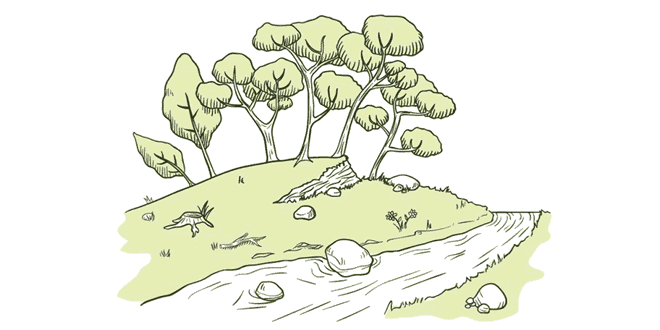Question: Write a note on the Brahmaputra Drainage System. OR Name any two major river systems of the Himalayan region. Describe any one in detail.
Answer: The Brahmaputra is one of the longest rivers of the world, but most of its course lies outside India. The river Brahmaputra rises in Tibet east of the Mansarovar lake. The river flows eastwards parallel to the Himalayas in its upper course. It is known as Tsangpo in Tibet. Here it carries smaller volume of water and less silt as it is a cold and dry area. The river takes a ‘U’-turn bend at Namcha Barwa (7757 m) and enters India in Arunachal Pradesh through a gorge. In Arunachal Pradesh, it is known as Dihang. Here it is joined by the Dibang, the Lohit, the Kenula and many other tributaries. The volume of the river increases and it is known as the Brahmaputra in Assam. The region receives heavy rainfall during the monsoon which increases the volume of water and silt content of the river. Devastating floods are caused by the river in Assam and Bangladesh every year during the rainy season. The deposition of the silt in the riverbed due to the heavy load, leads to the formation of braided channels intervened by riverine islands. The Brahmaputra has a braided channel in its entire length in Assam. Many riverine islands like the Majuli, the world’s largest riverine island, are formed in between the channels. The Brahmaputra is known as Jamuna in Bangladesh. Here it is joined by the Ganga, known here as Padma. Together they form the Ganga-Brahmaputra Delta known as Sunderbans, and discharge into the Bay of Bengal.
Question: What are perennial and non-perennial rivers? Give reasons why the Himalayan region consists of perennial rivers.
Answer: The rivers that flow throughout the year are termed as perennial rivers. They have more or less even flow throughout the year, e.g., the Ganga. The rivers that do not flow throughout the year are termed as non-perennial rivers. They are seasonal rivers that flow mainly during the rainy season and dwindle during the dry period, e.g., the Subarnarekha. The rivers of the Himalayan region are perennial in nature. They have their sources in the snow fields and glaciers of the Himalayas which supply water to these rivers throughout the year. During monsoons the Himalayas receive very heavy rainfall and rivers discharge heavy flow of water. During dry periods the rivers are fed by the melting snow and glaciers of the lofty great Himalayan range. Hence, the Himalayan rivers flow throughout the year.
Question: How are salt lakes formed? Give examples of salt lakes in India.
Ans. Lakes which have water with high salt content are called salt lakes. They are usually found in the basins of inland drainage in the regions of arid and semi-arid climate. Such lakes are seasonal in nature. Hollows may be created in the deserts due to the deflation action of the winds. These may reach the groundwater level which seeps out into these depressions. Small shallow lakes are formed which become salt lakes due to excessive evaporation. Sometimes short, intermittent streams drain into low depression or a desert basin and form temporary lakes. Such short lived lakes also contain high percentage of salts on account of high rate of evaporation. An example of such saltwater lake is the Sambhar lake of Rajasthan. The water of this salt lake is used for producing salt.
Question: What is a lagoon? How does it differ from a lake?
Answer: Lagoon is a stretch of brackish or salt water separated from the sea by a sandbank, bars, reefs, etc. The action of wind and waves along coasts builds spits and bars in the inlets of seas isolating lagoons from the sea. They are commonly found off the deltas of large rivers like the Ganges, the Mahanadi, etc. The Chilika lake of Orissa, the Pulicat lake of Tamil Nadu and the Kolleru lake of Andhra Pradesh are lagoons.Strong on shore winds are also capable of pushing the coastal sand dunes along beaches landwards. They may enclose marshy lagoons.
- Lagoons are found only in coastal areas, usually near the mouths of rivers, while lakes may be formed in any geographical location, in highlands or in inland basis.
- Lagoons have brackish water while a lake may have fresh water or salty water.
- Lagoons are formed due to wind and wave action in the coasts. Lakes may be of tectonic origin or may be formed due to river action, glacial action, wind. They may also be human-made artificial lakes.
 Class Notes NCERT Solutions for CBSE Students
Class Notes NCERT Solutions for CBSE Students



